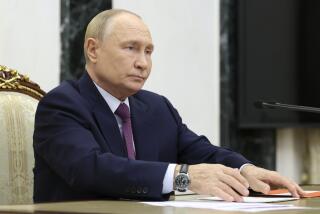Soviets Link Offensive, Defensive Arms Limits
- Share via
WASHINGTON — The Kremlin’s latest arms control proposal offers a choice of either moderate or deep cuts in offensive nuclear arms, depending on the degree to which the United States would curtail its Strategic Defense Initiative, a senior Reagan Administration official disclosed Tuesday.
Administration officials said that the Soviets’ new flexibility increases optimism that serious bargaining toward an arms accord will be possible this year.
The details of Moscow’s latest offer emerged a day after Soviet leader Mikhail S. Gorbachev publicly confirmed the substance of his government’s proposal. Gorbachev said that the Soviets proposed a moderate cut of roughly 30% to 35% in the number of long-range missiles and bombers on both sides--to 1,600 each--with a maximum of 8,000 warheads on those weapons.
They coupled those reductions with a call for a 15-year extension of the Anti-Ballistic Missile Treaty, in order to delay deployment of the U.S. “Star Wars” defense system. But Gorbachev indicated that laboratory research on space defenses would be permitted.
The Soviets also left on the table their earlier offer of a 50% cut in missiles and bombers--to 1,250 on each side, with 6,000 warheads each--if the United States would agree to prohibit all work, including laboratory research, on space defenses. Gorbachev and President Reagan agreed on a goal of a 50% cut during their summit meeting in Geneva last November.
Implicit in the Soviets’ new approach, officials said, is that they will consider less deep but still significant reductions in armaments along with weaker constraints on “Star Wars.” For example, a 20% cut in missiles and bombers with a limit of 10,000 warheads, along with a 10-year extension of the ABM treaty, might be attainable as an intermediate agreement.
Research Period Lengthy
“Star Wars” research is not expected to establish the feasibility of the program for at least five years and perhaps much longer. A U.S. commitment not to deploy space defenses for 5 or 10 years would therefore have minimal cost.
Thus, the Soviet move could open the door to genuine compromise, balancing cuts in offensive weapons and curtailment of space defenses, according to several experts.
But at least one Soviet specialist in the State Department remained unconvinced. “It shows flexibility in tactics rather than in substance,” he said, adding that it merely represents another attempt by the Kremlin to bring public pressure on Reagan to make concessions for a new arms agreement.
And Defense Secretary Caspar W. Weinberger told a breakfast meeting with reporters that the real Soviet purpose in making the new proposal was “to define SDI out of existence.”
Weinberger also said that contrary to predictions by Administration critics, Reagan’s decision to stop abiding by the unratified 1979 strategic arms agreement had not killed the arms talks in Geneva. He counted three Soviet proposals since Reagan’s May 27 decision on SALT II.
However, Harry Gelman, a Soviet specialist at the Rand Corp. in Santa Monica, agreed that while the new offer continues Soviet efforts to pressure the Reagan Administration toward arms concessions, “there’s enough there to explore at Geneva--to see how much give there actually is in the Soviet position.”
And White House spokesman Larry Speakes, responding to Gorbachev’s latest speech, said Tuesday that the Soviets have made “serious proposals” at the Geneva negotiations. “We are giving the matter serious study and consideration,” he said.
Kenneth L. Adelman, director of the U.S. Arms Control and Disarmament Agency, added: “There is increasing evidence that the Soviets may be serious on this issue. I would not have said this six months ago,” when Gorbachev made a sweeping proposal calling for complete nuclear disarmament by the year 2000.
“Since then, however,” Adelman said, “they seem to be talking more details and essentials of positions in Geneva. I’m not convinced they are serious, but there is evidence that they may be serious.”
A North Atlantic Treaty Organization diplomat, who was pessimistic about arms control prospects a month ago, said he is feeling better now as a result both of the new Soviet offer and, paradoxically, of the Reagan decision to stop observing the 1979 arms pact.
Pressure on Hard-Liners
“The effect of the SALT II announcement is to put pressure on Administration hard-liners to come up with a substitute for SALT II,” he said. “People are saying: ‘Okay, you killed SALT II because it was flawed, but what are you going to put in its place?’ ”
Weinberger made a point of saying that Reagan has killed the treaty. The 1979 agreement, he said, “is not in effect but it is being observed.” Although Reagan said he no longer feels bound by the pact, he ordered that two old Poseidon missile-carrying submarines be dismantled, as required by the treaty when the United States deploys a new Trident submarine.
On the other hand, the two key presidential arms control advisers are at head-to-head disagreement on the possibilities of remaining within the treaty’s limits later this year.
Paul H. Nitze told Congress last week that another Poseidon submarine might be dismantled later this year to offset the conversion of B-52 bombers to a capacity to carry cruise missiles. When the 131st B-52 is modified, it will exceed the SALT II limit of 1,320 multiple warhead weapons.
But Edward L. Rowny said: “There is no basis in fact for that conjecture. There are no plans or intentions to dismantle a third submarine in 1986.”
That third submarine is scheduled to be dismantled in the first half of next year, however, and its retirement could be advanced.
Weinberger says “Star Wars” wouldn’t halt all missiles. Page 16.
More to Read
Sign up for Essential California
The most important California stories and recommendations in your inbox every morning.
You may occasionally receive promotional content from the Los Angeles Times.













